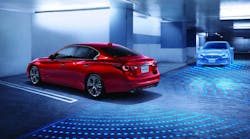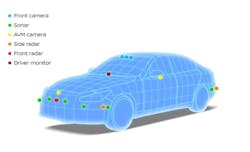Nissan Debuts Level 3 Self-Driving Tech
The rollout of ProPilot 2.0 driver-assistance technology featured in the new Nissan Skyline is the company’s first effort at enabling hands-off driving when the car is cruising in a single lane. ProPilot 2.0 employs Renesas’ R-Car automotive system-on-chip (SoC) and RH850 automotive control microcontroller (MCU) to implement self-driving functionality in the ECUs that handle driving judgment and response.
Designed for on-ramp to off-ramp (ramp-to-ramp) highway driving, ProPilot 2.0, now a Level 3 autonomous drive system, engages with the vehicle’s navigation system to help maneuver the car according to a predefined route on designated roadways. For the first time, the system also enables hands-off driving while cruising in a single lane.
Compared to the current ProPilot system, available in models like the 2019 Altima sedan and 2019 Rogue SUV, the next generation of ProPilot comes with more sensors and allows for a greater degree of driving autonomy. Previously, ProPilot would emit a series of chimes and visual warnings if it detected the driver’s hands weren’t on the wheel for more than two to three seconds. Should the driver keep failing to respond to these warnings, a ProPilot-equipped vehicle would start to slow the car down, turn on the hazard lights, and bring the vehicle to a stop in its lane of travel.
With ProPilot 2.0, an infrared camera sits in the middle of the Skyline's dashboard. It scans the driver’s eyes to make certain the person behind the wheel is paying attention to the road.
Once activated, ProPilot 2.0 uses seven cameras, five radar sensors, and 12 sonar sensors, combined with a 3D high-definition mapping navigation system to create a 360-degree image of the car’s surroundings (see figure). The technology can pinpoint the car's location to within 5 cm, according to Nissan.
ProPilot 2.0 employs seven cameras, five radar sensors, and 12 sonar sensors, combined with a 3D high-definition mapping navigation system. AVM stands for “Around View Monitor.” (Source: Nissan)
ProPilot 2.0 can maintain the vehicle’s lane position and adjust steering, braking, and acceleration to suit driving conditions. If the system detects a slower vehicle up ahead, it uses its sensor array to determine if it’s safe to pass. Visual and audio cues are relayed to the driver, letting him/her know when it’s safe to attempt a passing maneuver.
When the car has determined it’s safe to pass, the driver can agree by placing both hands on the steering wheel and activating a steering-wheel-mounted switch. Upon the driver's confirmation, the vehicle will move into the passing lane. Once it passes the slower vehicle and the system determines that it’s possible to return to the driving lane, the system requests confirmation from the driver to bring the vehicle back into the original lane.
When the vehicle approaches the highway exit of a predefined route, audio and visual guidance is given to notify the driver that navigated driving is about to end. Once the vehicle reaches the highway exit ramp, navigated driving is disengaged and the driver takes full control of the vehicle.
To achieve Level 3 autonomy, the Renesas R-Car SoC first creates detailed environment maps of the vehicle surroundings by combining information on nearby vehicles and other objects from the cameras and front radar with a 3D map data preloaded for navigation. The SoC determines the vehicle’s position from the map data and lane information and, based on this information, determines the vehicle’s action plan. The RH850 MCU receives the resulting data and sends control commands to the ECUs controlling the steering wheel, accelerator, and brakes.
“Realizing ProPilot 2.0 on the Skyline required the technological innovation of achieving performance that can handle real-time processing of several times more sensor data than ever before while maintaining reliability,” says Takashi Yoshizawa, VP, Alliance Global Director, EE and Systems Engineering Div., Nissan Motor Co.
Although the new ProPilot 2.0 system will be available this fall in Japan, it must still undergo more testing before premiering in North America, most likely on the updated Nissan Skyline luxury sedan which is sold in the U.S. as the Infiniti Q50.


